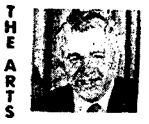
The arts in Maine
Iselin sculptures show delicacy
By Robert H. Newall Of The NEWS Staff
Bangor Daily News. Sot.•Sun . September 13-14,1975 7
ORONO - Perhaps the most salient feature of the metal sculptures anddrawings of Lewis Iselin — these constituting the major show for September at the University of Maine's Carnegie Hall, Gallery I — is the fact that there is a pointed similarity.
Just as the heroic figures that Michaelangelo painted on the ceiling and walls of the Sistine Chapel echo his monumental ventures into marble, so do the clean, delicate black and white drawings that Iselin has selected for this show demonstrate a likeness to the linear-oriented masks and figures in bronze.
The propagator of these fascinating art pieces — handsomely displayed — is Lewis Iselin, another art expatriate to Maine. Though born in New Rochelle, N.Y., he regularly summered here and, by virtue of his being a committed sailor, literally drifted into Camden to put down firm roots. "Had I delayed my appearance for six weeks, he said laughing, "I would have been a Maine native. But I showed up before our summer vacation started."
His father, a banker by profession and a RangleleyLakes fisherman by strong avocation, believed, as Benjamin Franklin's father did, that his children should be able to work with their hands. An accomplished cabinetmaker himself, the elder "Iselin did not insist upon a formal educational program for his son, who was graduated from St Mark's School before going on to Harvard for two years ... "I was a double drop-out," the rugged artist said. "But I needed a general education rather than specific courses."
Later he came under the benign tutelage of MahonriYoung, Sr.,a grandson of Brigham Young, the founder of Salt Lake City and the celebrated leader of the Mormons. "He did the great Brigham Young monument in Utah where his grandfather said prophetically, “This is the place,' " Iselincommented. "He was interested in the Mormanmovement as a sociological phenomenon, a colonizing force for the West. "As a child, Iselin had drawn constantly. "Since Mr. and Mrs. Charles Dana Gibson were neighbors of ours, I developed a liking for her," Iselin mused, "and I thought that if I practiced my drawing, I'd end up with her." Apart from fulfilled romantic aspirations, he doubtless got plenty of training for his eventual role as a draughtsman.
"Art," he philosophized, "was invented by illiterates to communicate with one another. It's non-verbal. At a given moment in your development, you never really quite know where you're at and you're never really conscious of what you do. You just do it. When I used to spend hours perusing the contents of the Metropolitan Museum, I discovered all sorts of tricks. 'Am I wrong to use these?' I asked Mahonri.'No, not now,' he replied. 'At 40 you'll be stuck with yourself in any case.' "
Iselin does most of his sculptures in large size because of a wax invented by Calvin Albert, a substance that has sufficient strength to build up an impressive form. "I was classically trained," Iselin explained, "and I got the touch of my materials. You can't go through too many reproductions of a given work without cheapening it or without injuring its character.
"There are two kinds of sculptures," he continued, "additive and subtractive. Someone who works in marble, for instance, falls into the latter group since he's chiseling away to get what he wants. But in bronze — and the majority of my things are in this category — one builds up rather than takes away. I've worked in stone, but I find that that's essentially a reproductive process as opposed to a straight creative impulse." There is, among moderns like Picasso, a third type known as the constructive technique. So far as his drawings go, he started out with black and white, a format he returned to when he settled in Camden. "The technique is unusual," he pointed out, "in as much as it's based on a fake way of making old-fashioned woodcuts. First, it's white on white. When it dries, it is covered with a wash. When that dries, India ink is spread over the whole thing. A coat of white poster paint (a Chinese paint water solvent, known as "gouache") comes off and what is left is the drawing."
As one- who has had his share of commissions — the last one came from a Columbus insurance company — Iselin feels keenly that one must do reams of research on historical figures, particularly those who were little photographed or who had not been painted. "I enjoyed doing Nathanael Greene of RhodeIsland," he said. "But when I came to Marshall Field, I had to work from one faded photograph. His nephew told me that he had cold gray eyes that grew colder the longer you were in the room. When you do a prominent person, you are creating him. If Napoleon were to come into the room and didn't look like the Canova portrait, we'd say he's a fake."
As one- who has had his share of commissions — the last one came from a Columbus insurance company — Iselin feels keenly that one must do reams of research on historical figures, particularly those who were little photographed or who had not been painted. "I enjoyed doing Nathanael Greene of Rhode
In addition to his passion for sailing, Iselin also has one for Paris, where he keeps an apartment just behind the Chambre des Deputes. During the winter months he and his wife, Sally, usually visit the French capital to keep up with the European art scene.
